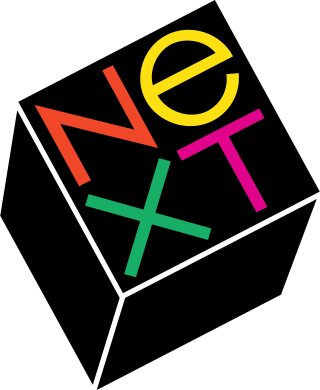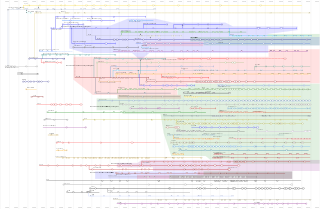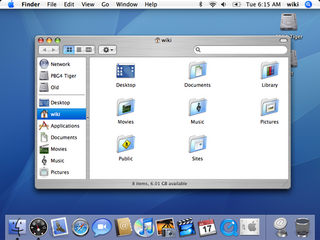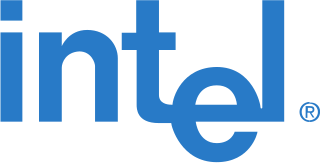Related Research Articles
QuickTime is a discontinued extensible multimedia architecture created by Apple, which supports playing, streaming, encoding, and transcoding a variety of digital media formats. The term QuickTime also refers to the QuickTime Player front-end media player application, which is built-into macOS, and was formerly available for Windows.

OpenStep is an object-oriented application programming interface (API) specification developed by NeXT. It provides a framework for building graphical user interfaces (GUIs) and developing software applications. OpenStep was designed to be platform-independent, allowing developers to write code that could run on multiple operating systems, including NeXTSTEP, Windows NT, and various Unix-based systems. It has influenced the development of other GUI frameworks, such as Cocoa for macOS, and GNUstep.

In computer architecture, 64-bit integers, memory addresses, or other data units are those that are 64 bits wide. Also, 64-bit central processing units (CPU) and arithmetic logic units (ALU) are those that are based on processor registers, address buses, or data buses of that size. A computer that uses such a processor is a 64-bit computer.
Macworld/iWorld was an information technology trade show with conference tracks dedicated to Apple's Mac platform. It was held annually in the United States during January. Originally Macworld Expo and then Macworld Conference & Exposition, the gathering dates back to 1985. The conference was organized by International Data Group (IDG), co-publisher of Macworld magazine.
Power Computing Corporation was the first company selected by Apple Inc to create Macintosh-compatible computers. Stephen “Steve” Kahng, a computer engineer best known for his design of the Leading Edge Model D, founded the company in November 1993. Power Computing started out with financial backing from Olivetti and Kahng.

A browser war is a competition for dominance in the usage share of web browsers. The "first browser war" (1995–2001) consisted of Internet Explorer and Netscape Navigator, and the "second browser war" (2004-2017) between Internet Explorer, Firefox, and Google Chrome.
Star Trek is the code name that was given to a secret prototype project, running a port of Macintosh System 7 and its applications on Intel-compatible x86 personal computers. The project, starting in February 1992, was conceived in collaboration between Apple Computer, who provided the majority of engineers, and Novell, who at the time was one of the leaders of cross-platform file-servers. The plan was that Novell would market the resulting OS as a challenge to Microsoft Windows, but the project was discontinued in 1993 and never released, although components were reused in other projects. The project was named after the Star Trek science fiction franchise with the slogan "To boldly go where no Mac has gone before".

Connectix Corporation was a software and hardware company that released innovative products that were either made obsolete as Apple Computer incorporated the ideas into system software, or were sold to other companies once they became popular. It was formed in October 1988 by Jon Garber; the dominant board members and co-founders were Garber, Bonnie Fought, and close friend Roy McDonald. McDonald was still Chief Executive Officer and president when Connectix finally closed in August 2003.

Mac OS X Tiger is the 5th major release of macOS, Apple's desktop and server operating system for Mac computers. Tiger was released to the public on April 29, 2005 for US$129.95 as the successor to Mac OS X 10.3 Panther. Included features were a fast searching system called Spotlight, a new version of the Safari web browser, Dashboard, a new 'Unified' theme, and improved support for 64-bit addressing on Power Mac G5s. Mac OS X 10.4 Tiger also had a number of additional features that Microsoft had spent several years struggling to add to Windows with acceptable performance, such as fast file search and improved graphics processing.

Intel Architecture Labs (IAL) was the personal-computer system research-and-development arm of Intel during the 1990s.
Video for Windows was a suite of video-playing and editing software introduced by Microsoft in 1992. A runtime version for viewing videos only was made available as a free add-on to Windows 3.1, which then became an integral component of Windows 95. Video for Windows was mostly replaced by the July 1996 release of ActiveMovie, later known as DirectShow. Apple filed a lawsuit in 1994 alleging theft of several thousand lines of QuickTime source code to improve the software. The case was settled in 1997, when Apple agreed to make Internet Explorer the default browser over Netscape, and in exchange, Microsoft agreed to continue developing Microsoft Office and other software for Mac OS for the next 5 years, and purchase $150 million of non-voting Apple stock.

Rhapsody is an operating system that was developed by Apple Computer after its purchase of NeXT in the late 1990s. It is the fifth major release of the Mach-based operating system that was developed at NeXT in the late 1980s, previously called OPENSTEP and NEXTSTEP. Rhapsody was targeted to developers for a transition period between the Classic Mac OS and Mac OS X. Rhapsody represented a new and exploratory strategy for Apple, more than an operating system, and runs on x86-based PCs and on Power Macintosh.

Indeo Video is a family of audio and video formats and codecs first released in 1992, and designed for real-time video playback on desktop CPUs. While its original version was related to Intel's DVI video stream format, a hardware-only codec for the compression of television-quality video onto compact discs, Indeo was distinguished by being one of the first codecs allowing full-speed video playback without using hardware acceleration. Also unlike Cinepak and TrueMotion S, the compression used the same Y'CbCr 4:2:0 colorspace as the ITU's H.261 and ISO's MPEG-1. Indeo use was free of charge to allow for broadest usage.
The Intel Graphics Media Accelerator (GMA) is a series of integrated graphics processors introduced in 2004 by Intel, replacing the earlier Intel Extreme Graphics series and being succeeded by the Intel HD and Iris Graphics series.
Flip4Mac from Telestream, Inc. was a digital media software for the macOS operating system. It was known for being the only QuickTime component for macOS to support Windows Media Video, and was distributed by Microsoft as a substitute after they discontinued their media player for Macintosh computers.

Mac OS X Snow Leopard is the seventh major release of macOS, Apple's desktop and server operating system for Macintosh computers.
Microsoft has been involved in numerous high-profile legal matters that involved litigation over the history of the company, including cases against the United States, the European Union, and competitors.
Mac operating systems were developed by Apple Inc. in a succession of two major series.
Intel Quick Sync Video is Intel's brand for its dedicated video encoding and decoding hardware core. Quick Sync was introduced with the Sandy Bridge CPU microarchitecture on 9 January 2011 and has been found on the die of Intel CPUs ever since.
Comparison of user features of operating systems refers to a comparison of the general user features of major operating systems in a narrative format. It does not encompass a full exhaustive comparison or description of all technical details of all operating systems. It is a comparison of basic roles and the most prominent features. It also includes the most important features of the operating system's origins, historical development, and role.
References
- ↑ "Court Order on Microsoft", New York Times, March 3, 1995
- ↑ Lea, Graham. "Maritz on… Apple", The Register, February 1st, 1999
- ↑ Chalmers, Rachel. "Apple And Microsoft: Jobs Barefoot Under A Tree", Computergram International, January 26, 1999
- ↑ Kawamoto, Dawn; Heskett, Ben; Ricciuti, Mike. "MS to invest $150 million in Apple", CNET News, August 6, 1997
- ↑ "Microsoft to Invest in Apple; Jobs, Ellison on Board" Archived 2007-09-30 at the Wayback Machine , PC World, August 6, 1997
- ↑ "Preferred Stock Purchase Agreement", FindLaw, August 5, 1997